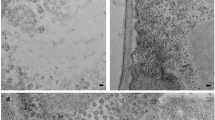Summary
New methods of fixation and embedding have revealed in plants infected withPetunia ringspot some structural features not described before. These include the X-bodies, 80 per cent of which are formed by tubular elements which are responsible for the positive staining specific for Golgi apparatus. The tubular elements are morphologically similar to agranular endoplasmic reticulum as described in some animal cells. The rest of the inclusion is formed by normal cytoplasmic elements in which are embedded long rod-shaped tubules 600 Å wide and more than 7,000 Å long, cross sections of which are formed by 10 subunits. These subunits are arranged in a helical way to form the large tubules. These subunits are probably the actual virus particles, which would be icosahedral and would form tubular “crystals”. Icosahedral virus particles would also form true crystalline inclusions.
It is not known what the role of the agranular endoplasmic reticulum and of some dense osmiophilic bodies found in it may be in the multiplication of the virus. However, these components induced by the virus infection probably result in the manufacture of some proteins or other substances necessary for virus multiplication.
Similar content being viewed by others
References
Blanchette, E. J., 1966: Ovarian steroid cells. II. The lutein cell. J. Cell Biol.31, 517–542.
Cronshaw, J., L. L. Hoefert, andK. Esau, 1966: Ultrastructural features ofBeta leaves infected with beet yellows virus. J. Cell Biol.31, 429–443.
Flaks, R., andP. Breslott, 1966: Some observations on the fine structure of the lutein cells of X irradiated rat ovary. J. Cell Biol.30, 227.
Hoefert, L. L., andK. Esau, 1967: Degeneration of sieve elements plastids in sugar beet infected with curly top virus. Virology31, 422–426.
Kiselev, N., G. L. Shiptzberg, andB. K. Vainshtein, 1967: Crystallization of catalase in the form of tubes with monomolecular walls. J. Molecular Biol.25, 433–454.
Kolemainen, L., H. Zech, andD. von Wettstein, 1965: The structure of cells duringtobacco mosaic virus reproduction. J. Cell Biol.25, 77.
Mann-Cops, Ch., 1964: Method for demonstrating Golgi material. In: Essentials of practical microtechnique.Geliner andKozloff (eds.). Philadelphia: Lea Febiger.
Markham, R. C.: Personal Communication.
Matsui, C., andA. Yamaguchi, 1966: Some aspects of plant virusesin situ. Advances in Virus Research12, 127–174.
McWhorter, F. P., 1965: Plants virus inclusions. Ann. Review Phytopath.3, 287–312.
Reynolds, E., 1965: Liver parenchymal cell injury III. The nature of calcium associated electron opaque masses in rat liver, mitochondria following poisoning with carbon tetrachloride. J. Cell Biol.25, 53–75.
Rubio-Huertos, M., 1954: Rapid extraction of intact crystalline inclusions from the cells of plants infected withtobacco mosaic virus. Nature174, 313.
—, 1959: Nota previa sobre un virus de tipo ringspot encontrado enPetunia hybrida Vilm. Microbiol. Españ.12, 325–329.
—, 1962: Light and elecron microscopy of inclusion bodies associated withPetunia ringspot virus. Virology18, 337–342.
Shalla, T., 1964: Assembly and aggregation oftobacco mosaic virus in Tomato leaflets. J. Cell Biol.21, 253–264.
Steere, R. L., andR. C. Williams, 1953: Identification of crystalline inclusions bodies extracted from plant cells infected withtobacco mosaic virus. Am. J. Bot.40, 81–84.
Zamboni, L., 1966: Fine structure of the human ovum in the pronuclear stage. J. Cell Biol.30, 579.
Author information
Authors and Affiliations
Rights and permissions
About this article
Cite this article
Rubio-Huertos, M. Further studies on ultrastructure of plants infected withPetunia ringspot virus. Protoplasma 65, 465–476 (1968). https://doi.org/10.1007/BF01666304
Received:
Issue Date:
DOI: https://doi.org/10.1007/BF01666304




